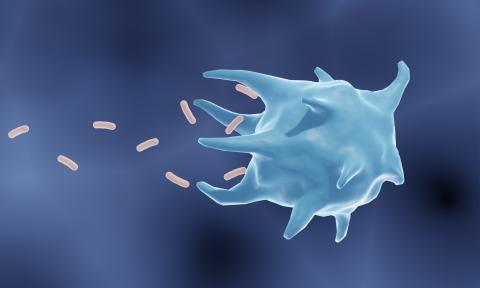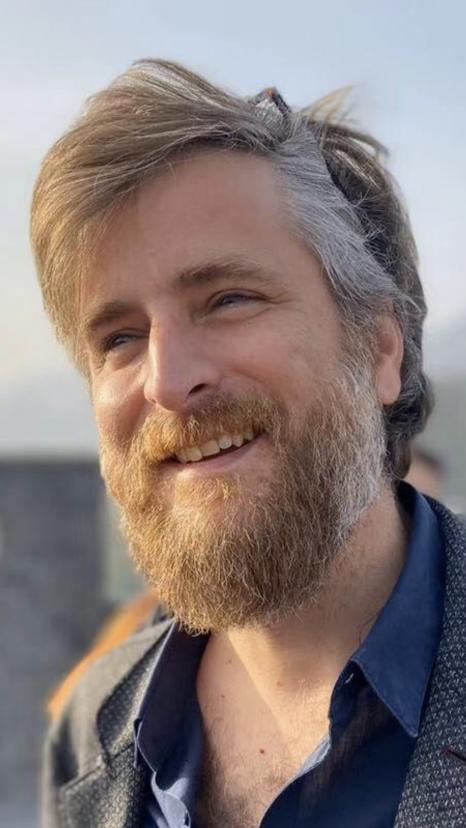
Florent Ginhoux: understanding the role of macrophages in the body
Florent Ginhoux is director of the Myeloid Cells and Cancer laboratory, part of the Tumour immunology and anti-cancer immunotherapy unit (ITIC – Univ. Paris-Saclay, Inserm, Gustave Roussy). A specialist in macrophage ontogeny and differentiation, he has been on the list of the world's most cited researchers since 2016. He is currently focusing his work on the identification of different types of tumour-associated macrophages for the future development of new immunotherapies targeting these cell populations.
After part of his childhood spent in Asia with his diplomat father, Florent Ginhoux studied biochemistry in France at the Pierre and Marie Curie University (now Sorbonne University) and gradually discovered an interest in immunology. "My Advanced Studies Diploma (DEA, a French postgraduate degree) at the Pasteur Institute was decisive in this sense, since it was especially during that year that I became fascinated by the immune system, which I found both very complicated and very logical."
Choosing to focus on research, in 2004 he began a PhD thesis at Genethon on the analysis of cytotoxic immune responses following gene transfer in the context of Duchenne muscular dystrophy. "So, in trying to understand how the detection of something new contributed to triggering the immune response, I became interested in dendritic cells. This was at a time when my colleagues were focusing more on T cells and B cells in their research."
A decisive meeting
After completing his PhD, Florent Ginhoux began looking for a laboratory in which to continue studying these dendritic cells, which are the first line of defence in triggering the immune response. "My good fortune then was to cross paths with the woman who would become my mentor, Professor Miriam Merad, who was planning to set up a laboratory in New York devoted to understanding the origin and function of dendritic cells."
When she proposed he follow her across the Atlantic to complete his doctoral internship, Florent Ginhoux had no doubts and flew to the United States in 2004. "I lived there for four magical years, of hard work, of intellectual synergy. It is also where I started my family. It was really a very important moment in my life," he recalls.
An original approach: understanding the function of cells through their development
While researchers studying dendritic cells at the time were focusing on the function of these cells to see how to attenuate or increase an immune response, in Miriam Merad's laboratory, they were more interested in the origin of these cells and their development. "With this descriptive cell ontogeny approach, our ambition was to understand the molecular mechanisms of dendritic cell formation through their phenotypic and transcriptomic identity."
This goal has been largely achieved, since these four years of research have not only allowed the characterisation of the development of these dendritic cells in mice and humans, but also the renewal of the tools and research methods in the field. "To better understand the development of these dendritic cells, we had to succeed in following them over time. We therefore decided to introduce the tracing tools used by our neurological colleagues into immunology," explains the researcher.
From dendritic cells to macrophages
Based on these first results in terms of the description and understanding of dendritic cells, Florent Ginhoux's team decided to apply the same ontogeny and cell tracing approach to the development of macrophages. "While everyone agreed at the time that macrophages came from blood monocytes, we showed that in mice, the majority of tissue macrophages came from embryonic precursors generated in the yolk sac, developing in utero during the first wave of hematopoiesis," explains the researcher.
While this rediscovery of the embryonic origin of macrophages, which was published in Science in 2010, opened up numerous new fields of research, it also constituted a very definite turning point in Florent Ginhoux's career. "It was this breakthrough that prompted me to pursue my research in Singapore and that has been the basis of my work for the past 15 years," he says.
Towards the culture of immuno-organoids
After finding out about Philippe Kourilsky's creation of an Institute of Immunology in Singapore, Florent Ginhoux packed his bags again in 2009 to join the Singapore Immunology Network (SIgN). "It was an incredible opportunity, with five years of funding, access to cutting-edge tools and a laboratory that had up to 30 people," recalls Florent Ginhoux.
His research problem was then the following: how to make human macrophages that resemble these 'yolk sac' macrophages that are inaccessible because they develop in utero. "We developed an approach using pluripotent stem cells to generate custom macrophages that we then integrated into different 2D and 3D models in order to observe their differentiation and better understand their functions," he explains. This was a revolutionary approach that led to another major advance by Florent Ginhoux's team: the generation of brain immuno-organoids.
Modelling paediatric brain cancer
After twelve years as an expatriate, Florent Ginhoux considered leaving Singapore and a new opportunity came up: the Gustave Roussy Foundation asked him to head an ambitious and ground-breaking new programme on understanding the role of macrophages in the development of paediatric cancer.
He came back to France in 2021, and embarked on this new adventure. "Based on our progress in the generation of 'mini-brains', we are trying, in this programme, to create organ avatars of sorts - in this case brains - in young pediatric cancer patients. Thanks to these avatars, we can observe how macrophages promote tumour growth and hope to find molecules that interact between macrophages and tumour cells in order to test new drugs," explains Florent Ginhoux.
The opening for a common thread
During his periods overseas, Florent Ginhoux admits to having acquired a form of open-mindedness that has certainly transformed his way of doing science. "In the United States, in addition to optimism, I learned not to work in a vacuum, to reach out to others, to open up projects to the right people in order to move faster." In Singapore, where he focused on human immunology, he was more in touch with the world of clinicians and industry. As a result, he worked in a laboratory associated with GSK in the United Kingdom from 2016 to 2019. "I am convinced that it is by stepping outside the box, by standing at the borderline between disciplines and methods, that we make the most progress," he concludes.

